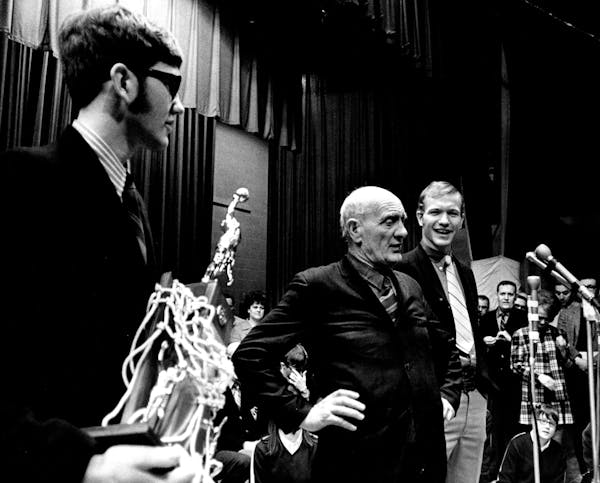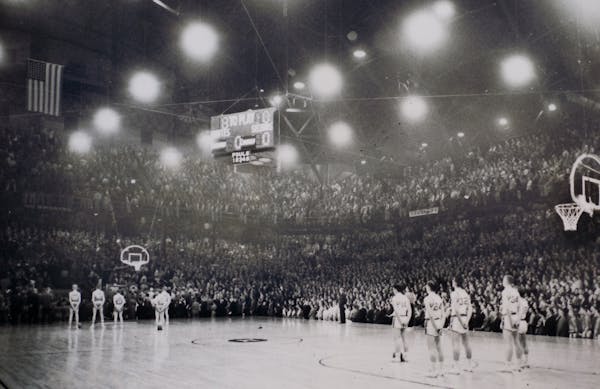 See
more of the story
See
more of the story
There were the usual 18,000 customers inside Williams Arena to watch a state one-class basketball champion determined on March 21, 1970. The unbeaten Sherburn Raiders, from a town of 1,300 and surrounded by farm families, were facing the South St. Paul Packers, so named for the city's stockyards that were distinctive in production and aroma.
Elmer Mulso was a cattle man in Sherburn, and he sent regular shipments of those four-legged critters to South St. Paul to be sacrificed for the taste buds of mankind.
As it turned out, South St. Paul's basketball team was sacrificed to Tom Mulso, the youngest of Elmer's three sons, inside the Barn on a Saturday night a half-century ago.
Mulso scored 39 points, fouled out Packers star Kurt Virgin, and the Raiders put away the big-city opponents in the fourth quarter 78-62.
Roxie Aho wrote the game story for the Minneapolis Sunday Tribune, describing Mulso as "a 6-foot-6 forward who likes to shoot from as far as 30 feet out." Mulso's height was inflated by an inch, although not his shooting range.
"I've wondered a few times how many of those would've been threes," Mulso said a few days ago. "I've never gone as far to watch that game and try to figure it out."
The three-point shot became a staple in high school basketball in fall 1987. Change came to the Minnesota boys' basketball tournament much sooner. A month after another eight-team boys' tourney brought huge crowds to a full-sized Williams, the Minnesota State High School League announced there would be two-class tournaments starting in 1971.
Jeff McCarron, Mulso's 6-5 co-star, said: "We did not know it at the time, but to be the last true one-class winner … there's a history to it that makes our championship more significant for a lot of people."
You want to know how the one-class boys' "State Tourney" was embraced here? Go back and watch "Hoosiers," the film from 1986.
Mostly, the Minnesota comparison to Gene Hackman's Hickory Huskers has been reserved for the Edgerton Flying Dutchmen, the 1960 champions from a tinier hamlet than Sherburn.
When it comes to actuality, Sherburn had the Huskers' story 16 years before "Hoosiers," when the basketball team adopted the town's recluse, George Packard, and took him along for the ride throughout that glorious winter. George was a precursor to Dennis Hopper's "Shooter" character, without the drinking problem.
Packard's tale doesn't stand alone with the small-town quaintness that existed between the Raiders and the townsfolk.
"We had Wells coming to town one night, a longtime power in our area," McCarron said. "The gym was full by 4:30; they turned away 400 people.
"We went out to warm up and Mulso and I noticed that Walt Smith wasn't in his usual seat in the front row. Walt was there every game, same place.
"Mulso and I found a phone, called and ask, 'Walt, where are you?' He said he couldn't get in.
"We said, 'You know that back door to the industrial arts area, don't you? Meet you there in five minutes.' We sneaked him in and Walt watched us beat Wells."
John Tirevold was the third senior starter, the guard responsible for making certain the Raiders played at the rapid pace sought by second-year coach Dennis Christofferson.
The other starters were sophomores: Pete Eiden, tough inside, and guard Paul Krohn, outstanding when relied on.
The popular theory is Sherburn was a large underdog to South St. Paul. Not so much — not when the M & M Boys were two of Minnesota's top five players, as demonstrated in the state tournament:
Mulso had 29 points when the Raiders beat Melrose 78-64 in the opener. McCarron had 37 points and 24 rebounds when they beat Marshall 71-60 in the semifinals. Mulso had the fabulous 39 in the final.
Two athletes like that, growing up three blocks apart, and to 6-foot-5, on the flat lands of southwestern Minnesota? Remarkable.
"Mulso and I met when we were 3," McCarron said. "We played hundreds of hours of basketball on the basket behind the grade school … with maybe a 9-foot-rim. Lots of one-on-one."
Yes, said Mulso, one-on-one that forced him into the quick release that triggered that magnificent jump shot. "I had to get that shot up quick, before McCarron got me in that left-arm hook of his," he said.
Mulso went to the University of Minnesota on a basketball scholarship for George Hanson's one season (1970-71). McCarron went on a football scholarship for Murray Warmath's last season.
Freshmen weren't eligible for varsity competition; then Bill Musselman came in as basketball coach. "I was on a football scholarship, so Musselman didn't bother me," McCarron said. "He wasn't too nice to Tom. He wanted the scholarship."
Mulso said: "I'm proud to be first Gopher to transfer to get away from Musselman. I thought he was crazy."
Mulso and McCarron wound up at Augustana in Sioux Falls and were excellent collegians (McCarron in two sports). They played on a European basketball tour together for a few months after college, and went their separate ways.
McCarron was in teaching, then became a passionate supporter of youth basketball in this region. Mulso rode the wild wave of sales in music radio in various locales, including the raucous days when KQRS-FM was becoming a juggernaut.
McCarron runs Pacesetter Sports, with its huge connection to youth basketball, at home in Paynesville, Minn. Mulso is now with a handful of music stations in Palm Springs, Calif.
McCarron had hundreds of teams signed up for his Pacesetter youth tournaments (right now was prime time) that are being lost to the coronavirus. Mulso's stations were deeply involved with the famed Coachella Music Festival, and that has been canceled.
McCarron: "We'll be back. Kids love basketball."
Mulso: "It's a bloodbath for us financially."
The conversation with Mulso lasted for a half-hour. At one point, he was heard saying, "I'll be there in a minute, honey. Everything's fine."
The voice in the background was Linda, Mulso's wife. "Painting was a hobby for her, but she was so good people started buying her work," Mulso said. "She's a very talented woman."
They have been a couple for 13 years. Mulso noticed small signs of memory loss with Linda a few years ago. It was early onset Alzheimer's disease.
"Linda's at home with me; she still knows me," Mulso said. "That's what keeps us going."
Fifty years. Quite a stretch of time. The wins can be much smaller, but as rewarding.







